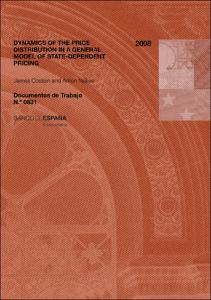Registro completo de metadatos
| Campo DC | Valor |
|---|---|
| dc.contributor.author | Costain, James |
| dc.contributor.author | Nakov, Anton |
| dc.date.accessioned | 2019-08-10T17:53:08Z |
| dc.date.available | 2019-08-10T17:53:08Z |
| dc.date.issued | 2009-01-08 |
| dc.identifier.issn | ISSN: 0213-2710 (en papel) |
| dc.identifier.issn | ISSN: 1579-8666 (en línea) |
| dc.identifier.uri | https://repositorio.bde.es/handle/123456789/6962 |
| dc.description.abstract | This paper analyzes the effects of monetary shocks in a DSGE model that allows for a general form of smoothly state-dependent pricing by firms. As in Dotsey, King, and Wolman (1999) and Caballero and Engel (2007), our setup is based on one fundamental property: firms are more likely to adjust their prices when doing so is more valuable. The exogenous timing (Calvo 1983) and fixed menu cost (Golosov and Lucas 2007) models are nested as limiting cases of our setup. Our model is calibrated to match the steady-state distribution of price adjustments in microdata |
| dc.description.abstract | realism calls for firm-specific shocks. Computing a dynamic general equilibrium requires us to calculate how the distribution of prices and productivities evolves over time. We solve the model using the method of Reiter (2008), which is well-suited to this type of problem because it combines a fully nonlinear treatment of firm-level state variables with a linearization of the aggregate dynamics. We compute impulse responses to iid and autocorrelated money growth shocks, and decompose the inflation impact into 'intensive margin', 'extensive margin' and 'selection' components. Under our most successful calibration, increased money growth causes a persistent rise in inflation and output. The real effects are substantially larger if money growth is autocorrelated. In contrast, if we instead impose a fixed menu cost specification, money growth shocks cause a sharp spike in inflation (via the selection component) so that the real effects are small and short-lived, especially if money growth is iid |
| dc.format.extent | 47 p. : gráf. |
| dc.language.iso | en |
| dc.publisher | Banco de España |
| dc.relation.ispartof | Documentos de Trabajo / Banco de España, 0831 |
| dc.rights | Reconocimiento-NoComercial-CompartirIgual 4.0 Internacional (CC BY-NC-SA 4.0) |
| dc.rights | In Copyright - Non Commercial Use Permitted |
| dc.rights.uri | https://creativecommons.org/licenses/by-nc-sa/4.0/deed.es_ES |
| dc.rights.uri | http://rightsstatements.org/vocab/InC-NC/1.0/ |
| dc.subject | Price stickiness |
| dc.subject | State-dependent pricing |
| dc.subject | Stochastic menu costs |
| dc.subject | Generalized (S,s) |
| dc.subject | Heterogenous agents |
| dc.subject | Distributional dynamics |
| dc.title | Dynamics of the price in a general model of state-dependent pricing |
| dc.type | Documento de trabajo |
| dc.identifier.bdebib | 000220308 |
| dc.identifier.bdepub | DTRA-200831-eng |
| dc.subject.bde | Métodos Econométricos y Estadísticos |
| dc.subject.bde | Fluctuaciones y ciclos económicos |
| dc.publisher.bde | Madrid : Banco de España, 2008 |
| dc.subject.jel | E31 |
| dc.subject.jel | E52 |
| dc.subject.jel | D81 |












